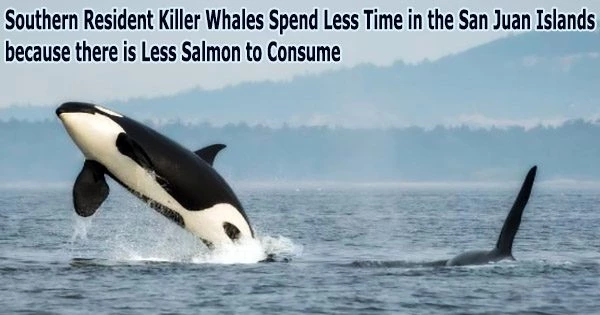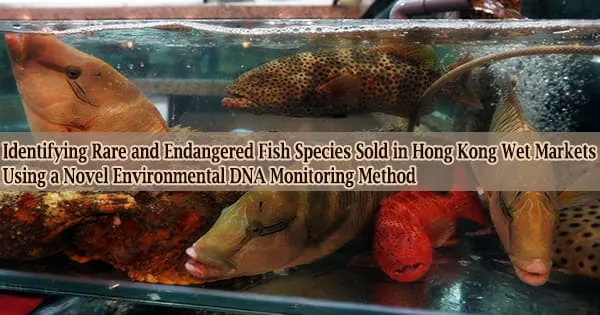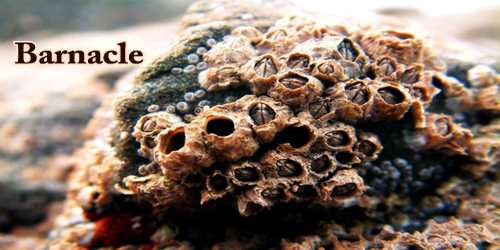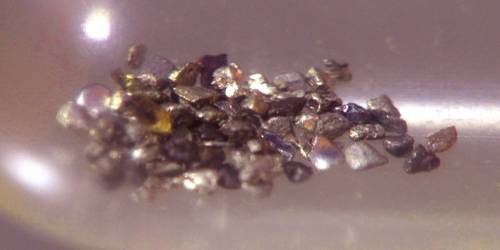A new study reveals that the endangered Southern Resident killer whale population, which is known to frequent the Salish Sea off the shores of Washington and British Columbia, is spending significantly less time there as a crucial food source declines.
The Salish Sea region surrounding the San Juan Islands has long been a haven for whales. The majority of the Chinook salmon consumed by the Southern Residents during the summer months came from the Fraser River stock, which travels through the islands on its route to spawning grounds upstream.
“But 17 years of whale sighting data shows that as the Fraser River Chinook salmon population dropped, the time spent by the Southern Residents around the San Juan Islands also declined by more than 75%,” said Joshua Stewart, an assistant professor with Oregon State University’s Marine Mammal Institute and the study’s lead author.
The findings were just published in the journal Marine Mammal Science. Co-authors of the paper are Jane Cogan, an independent researcher in Friday Harbor, Washington; John Durban, a professor with MMI who is also affiliated with the nonprofit SeaLife Response, Rehabilitation and Research (SR3); Holly Fearnback of SR3; David Ellifrit, Mark Malleson and Ken Balcomb of the nonprofit Center for Whale Research; and Melisa Pinnow of San Juan Orcas, a website dedicated to identification of individual orcas.
“This is an endangered population that is in decline with only 73 whales remaining, and prey limitation appears to be an important factor,” Stewart said. “A huge part of these whales’ time used to be spent feeding in this area.”
This new study demonstrates that as the whales’ main summer feeding sites become less dependable and fruitful, they are forced to look elsewhere for prey, increasing concerns about the population’s health.
But 17 years of whale sighting data shows that as the Fraser River Chinook salmon population dropped, the time spent by the Southern Residents around the San Juan Islands also declined by more than 75%.
Professor Joshua Stewart
The Southern Resident killer whale population is comprised of three matriarchal pods J, K and L that have traditionally been seen in the Salish Sea region between April and October. The J pod is more frequently found in the Salish Sea throughout the year, while the K and L pods cover a wider geographic range, particularly in winter and spring.
“Research we are conducting on body condition using drones is revealing that the summer is an essential feeding period when the Southern Residents load up on returning salmon before the slimmer winter months,” said Fearnbach.
The Southern Resident population has been in decline since 1995 and is listed as endangered under both the U.S. Endangered Species Act and the Canadian Species at Risk Act. Past research has shown three possible drivers of the whales’ decline: limited availability of their primary prey, Chinook salmon; vessel disturbance in the Salish Sea; and high levels of pollutants in their core habitat, Stewart said.
It’s critical to comprehend the foraging behavior of Southern Residents when creating plans to aid in the species’ recovery. The largest and best salmon in the Southern Residents’ foraging zone are Chinook salmon from the Fraser River.
“The fish help the whales build up blubber stores in the summer to get through the winter and early spring when prey are of lower quality and harder to find,” Stewart said.
Stewart examined nearly 20 years’ worth of whale sighting data gathered through reports from naturalists and researchers throughout the Salish Sea in an effort to learn more about the connections between the foraging behavior of the Southern Resident whales and the abundance of Fraser River Chinook salmon.
The data collection was led by the Center for Whale Research and augmented by Pinnow and Cogan, who collected observation information from naturalists and the public.
“Working with the Center for Whale Research and a broad network of researchers, naturalists and citizen scientists, we were able to generate a far more detailed accounting of the Southern Residents’ movements and occupancy around the San Juan Islands and their traditional summer habitat,” Cogan said.
The team’s primary source of data was sighting information for individual whales, which they gathered via public and scientifically taken photos as well as hydrophone detections that could be connected to each pod.
Cogan’s data showed that the number of days each pod of Southern Resident killer whales was present in the San Juan Islands declined each year between 2004 and 2020. J pod was generally present in the area more frequently than the other two pods, with a high of 164 days in 2005 and a low of just 36 days in 2017. L pod was present in the core habitat for only 10 days in 2019, compared with a high of 103 days in 2004.
When the whales’ presence was compared to information on Chinook salmon returns to Fraser River tributaries over the same time period, a significant correlation was found. Whales were more frequent during years with higher salmon returns, while Southern Residents were less active during years with lower salmon returns.
“They went from spending the majority of their time in this habitat, to just a fraction of their summer,” Stewart said. “This shift is likely an effort to find alternative food sources.”
Durban, who conducts drone-based health assessments of the whales with Fearnbach, said the loss of salmon is already impacting the health of the whales. A recent review of the body condition data from Durban and Fearnbach showed that when there are more Chinook returning to the Fraser River, the condition of the whales, especially J-pod, is better.
“This further suggests that lack of prey is likely the biggest stressor for these whales,” said Durban, a population ecologist. “The other stressors pollutants and vessel disturbances are compounded by the lack of prey. If there are fewer fish, disturbance by vessels may become more disruptive to their foraging success.”
The Marine Mammal Institute is part of OSU’s College of Agricultural Sciences and based at Hatfield Marine Science Center in Newport.
















